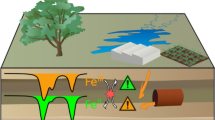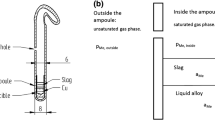Abstract
The subsolidus region of the Fe-W-S system was studied by experiments performed in evacuated silica tubes. Ternary phases were not encountered. Tungsten disulphide WS2 is stable with the iron sulphides but not with metallic iron. The major tie-line pyrrhotite-tungsten differentiates this system from the analogous Fe-Mo-S system. Experiments on the Fe-W-O-S system demonstrate that WS2 (tungstenite) is not stable in the presence of iron oxides. Molybdenum and tungsten show different affinities to sulphur which is manifested in nature in abundant molybdenite as contrasted with rare tungstenite. Sulphur fugacity data in the literature differ on WS2. There data are compared with the present experimental results.
Zusammenfassung
Das ternäre System Fe-W-S wird durch Abschreckungsexperimente in evakuierten Quarzglasampullen sowie durch Differential-Thermoanalyse untersucht, die Phasengleichgewichtsbeziehungen sind in einem isothermen Digramm T<743 °C veranschaulicht. Unterhalb 743±2 °C liegt der Stabilitätsbereich des Pyrits, FeS2, welcher mit Tungstenit, WS2, koexistiert. Konodenscharen erstrecken sich ferner von WS2 zu Pyrrhotin und zwar über einen weiten Bereich der Fe1-xS-Mischkristallreihe. Von FeS, oder annähernd stöchiometrischem FeS verlaufen Konoden zum metallischen Wolfram und zu den intermetallischen Phasen Fe2W und Fe3W2. Eine ternäre Phase wurde nicht gefunden. Experimente im ternären sowie im quaternären System Fe-W-O-S demonstrieren, daß WS2 weder mit metallischem Eisen noch mit Eisenoxiden stabil ist. Molybdän und Wolfram zeichnen sich durch unterschiedliche Affinität zu Schwefel aus, und daraus resultierende Schlußfolgerungen werden in bezug auf natürliche Mineralvergesellschaftungen diskutiert. Die in der einschlägigen Literatur gemachten Angaben über die Schwefelfugazität von Fe, Mo und W werden kritisch untersucht. Dominierende Unterschiede hinsichtlich der Phasengleichgewichtsbeziehungen des Fe-W-S-Diagrammes zu anderen Fe-beinhaltenden Sulfidsystemen, wie Fe-Mo-S, Fe-Sn-S und Fe-Bi-S, werden aufgezeigt.
Similar content being viewed by others
References
Arnold, R. G.: Equilibrium relations between pyrrhotite and pyrite from 325° to 743 °C. Econ. Geol. 57, 72–90 (1962).
Berry, L. G., Thompson, R. M.: X-ray powder data for ore minerals. Mem. Geol. Soc. Amer. 85, 281 (1962).
Barton, P. B., jr., Skinner, B. J.: In H. L. Barnes, Geochemistry of hydrothermal ore deposits, p. 236–333. New York—London: Holt, Rinehart and Winston, Inc. 1967.
Betekhtin, A. G.: Hydrothermal solutions, their nature and processes of mineral deposition. In: Fundamental problems in the study of magmatogenous ore deposits, p. 125–278. Moskva: Izd. A.N.U.S.S.R. 1955 (in Russian).
Brett, R., Kullerud, G.: The Fe-Pb-S system. Econ. Geol. 62, 354–367 (1967).
Buzek, Z., Prabhala, K. S.: Character and type of solution of S in the Fe-S-Ni and Fe-S-Cr systems. Sb. Věd. prací Vysoké školy báňské v Ostravě 11, 563–568 (1965) (in Czech).
Cambel, B., Jarkovský, J.: Geochemistry of pyrrhotite of various genetic types, 333 p. Bratislava: Commenius University 1969.
Ehrlich, P.: Untersuchungen an Wolframsulfiden. Z. Anorg. Chem. 257, 247–253 (1948).
Elliot, R. P.: Constitution of binary alloys, 877 p. First supplement. New York: McGraw-Hill 1965.
Graeser, S.: Über Funde der neuen rhomboedrischen MoS2-Modifikation (Molybdänit 3R) und von Tungstenit in den Alpen. Schweiz. Mineral. Petrog. Mitt. 44, 121–128 (1964).
Grover, B., Moh, G.: Experimentelle Untersuchungen des quaternaren Systems Kupfer-Eisen-Molybdän-Schwefel. Referat 44. Jahrestagung der Deutschen Mineralogischen Gesellschaft, München 1966.
Hansen, M., Anderko, K.: Constitution of binary alloys, 2nd ed., 1305 p. New York: McGraw-Hill 1958.
Holland, H. D.: Some applications of thermochemical data to problems of ore deposits. II. Mineral assemblages and the composition of ore-forming fluids. Econ. Geol. 60, 1101–1166 (1965).
Jellinek, F.: Sulfides of the transition metals of groups IV, V and VI. Arkiv Kemi 20, 447–480 (1963).
Krauskopf, K. B.: Heavy metal content of magmatic vapor. Econ. Geol. 52, 796–807 (1957).
— The possible role of volatile compounds in ore genesis. Econ. Geol. 59, 22–45 (1964).
Kubaschewski, O., Evans, E.: Metallurgical thermochemistry, 368 p. London: Butterworth-Springer 1951 (Russian translation).
Kullerud, G., Yoder, H. S.: Pyrite stability relations in the Fe-S system. Econ. Geol. 54, 533–572 (1959).
— Two liquid fields in the Fe-S system. Carnegie Inst. Wash. Year Book 60, 174–176 (1961).
— Buseck, P. R.: The Fe-Mo-S system. Carnegie Inst. Wash. Year. Book 61, 150–151 (1962).
— The Fe-Mo-S system. Carnegie Inst. Wash. Year Book 65, 337–342 (1966).
Moh, G.: The Fe-Mo-S system and related minerals (personal communication, 1970).
Palache, C., Berman, H., Frondel, C.: The system of mineralogy, vol. 1, 834 p. New York: John Wiley and Sons 1944.
Richardson, F. D., Jeffes, J. H. E.: The thermodynamics of substances of interest in iron and steel making. III. Sulphides. J. Iron Steel Inst. (London) 171, 1034–1038 (1952).
Samoilov, S. M., Rubinstein, A. N.: Study of physical and chemical properties of WS2 catalysator. Izv. Akad. Nauk SSSR, otdel. khim. nauk, No 11, 11905–11912 (1959) (in Russian).
Toulmin, P., Barton, P. B.: A thermodynamic study of pyrite and pyrrhotite. Geochim. Cosmochim. Acta 28, 641–671 (1964).
Vogel, R., Weizenkorn, H. H.: Über das Dreistoffsystem Eisen-Schwefel-Wolfram. Arch. Eisenhüttenw. 32, 413–420 (1961).
— Ergebnisse ternärer Zustandsdiagramme des Eisens, angewandt auf Fragen der Kosmochemie. Chem. Erde 21, 22–47 (1962).
Wells, R. C., Butler, B. S.: Tungstenite, a new mineral. J. Wash. Acad. Sci. 7, 596–599 (1917).
Wiendl, U.: Zur Geochemie und Lagerstättenkunde des Wolframs. Dissertation der Technischen Universität Clausthal, 295 p., 1968.
Wilderwanck, J. C., Jellinek, F.: Preparation and crystallinity of molybdenum and tungsten sulfides. Z. Anorg. Chem. 328, 309–318 (1964).
Author information
Authors and Affiliations
Rights and permissions
About this article
Cite this article
Štemprok, M. The iron-tungsten-sulphur system and its geological application. Mineral. Deposita 6, 302–312 (1971). https://doi.org/10.1007/BF00201888
Received:
Issue Date:
DOI: https://doi.org/10.1007/BF00201888




